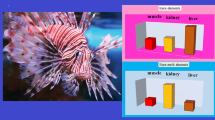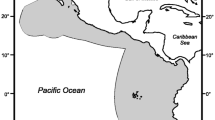Abstract
This study aimed to establish the distribution of As, Cd, Cu, Pb, and Zn, in the muscle and liver of the spotted ratfish Hydrolagus colliei from the northern Gulf of California to establish the bioaccumulation background data in this species. The individuals (n = 110) were obtained by bycatch from the Gulf of California hake fisheries, and the metals and metalloid were measured by atomic absorption spectrometry. The element with the highest concentration in the muscle (15.19 ± 5.40 mg kg−1) and the liver (20.98 ± 10.30 mg kg−1) was As, followed by essential elements (Zn > Cu), and the lowest were the non-essential Pb (0.029 ± 0.014 and 0.048 ± 0.038 mg kg−1, muscle and liver, respectively) and Cd (0.022 ± 0.014 and 0.796 ± 0.495 mg kg−1, muscle and liver, respectively). The liver showed higher bioaccumulation than the muscle in all the studied elements. The sex was not a factor that influenced the bioaccumulation. The concentrations of As in the muscle did not exceed the maximum permissible limits of Mexican legislation, and < 50% of the samples exceed Cd and Pb limits of the Mexican, European Union, and WHO/FAO regulations. The differences found between the elements and tissues could be related to the different diets of the species, their migratory patterns, and their life conditions. Studies in the deep-sea water H. colliei are limited, and further investigations are needed regarding the feeding habits of H. colliei as well as the interactions of potentially toxic elements within the deep-sea water habitat.

Similar content being viewed by others
Data Availability
The datasets generated during and/or analyzed during the current study are not publicly available but are available from the corresponding author on request.
References
Del Moral-Flores LF, Pérez-Ponce de León G (2013) Tiburones, Rayas y quimeras de México. Biodiversitas, Mexico.
Bizarro JJ, Smith WD, Márquez-Farías JF, Tyminsky J, Hueter RE (2009) Temporal variation in the artisanal elasmobranch fishery of Sonora, Mexico. Fish Res 97:103–117. https://doi.org/10.1016/j.fishres.2009.01.009
Barnett LAK, Earley RL, Ebert DA, Cailliet GM (2009) Maturity, fecundity, and reproductive cycle of the spotted ratfish, Hydrolagus colliei. Mar Biol 156:301–316. https://doi.org/10.1007/s00227-008-1084-y
King JR, Mcphie RP (2015) Preliminary age, growth and maturity estimates of spotted ratfish (Hydrolagus colliei) in British Columbia. Deep Sea Res Part II Top Stud Oceanogr 115:55–63. https://doi.org/10.1016/J.DSR2.2013.11.002
Froese R, Pauly D (2022) Fish base. Hydrolagus colliei (Lay & Bennett, 1839) Spotted ratfish. https://www.fishbase.in/summary/Hydrolagus-colliei.html. Accessed 20 April 2022.
Torres AI, Rivera-Hernández JR, Giarratan E, Faleschini M, Green-Ruiz CR, Gil MN (2019) Potentially toxic elements and biochemical components in surface sediments of NW Mexico: an assessment of contamination and trophic status. Mar Pollut Bull 149:110633. https://doi.org/10.1016/j.marpolbul.2019.110633
Hazrat A, Khan E, Ilahi I (2019) Environmental chemistry and ecotoxicology of hazardous heavy metals: environmental persistence, toxicity and bioaccumulation. J Chem 6730305 https://doi.org/10.1155/2019/6730305
Soto-Jiménez FM (2011) Transferencia de elementos traza en tramas tróficas acuáticas. Hidrobiológica 21:239–248
Páez-Osuna F, Álvarez-Borrego S, Ruiz-Fernández AC, García-Hernández JC, Jara-Marini ME, Bergés-Tiznado ME, Piñón-Gimate A, Alonso-Rodriguez R, Soto-Jiménez MF, Frías-Espericueta MG, Ruelas-Inzunza JR, Green-Ruiz CR, Osuna-Martínez CC, Sánchez-Cabeza JA (2019) Environmental status of the Gulf of California: a pollution review. Earth Sci Rev 166:181–205. https://doi.org/10.1016/j.earscirev.2017.01.014
Agency for Toxic Substances and Disease Registry (2020) ATSDR’s Substance Priority List. https://www.atsdr.cdc.gov/spl/#. Accessed 3 April 2022
Osuna-Martínez CC, Armenta A, Bergés-Tiznado ME, Páez-Osuna F (2021) Arsenic in waters, soils, sediments and biota from Mexico: an environmental review. Sci Total Environ 752:142062. https://doi.org/10.1016/j.scitotenv.2020.142062
Cruz-Acevedo E, Betancourt-Lozano M, Arizmendi-Rodríguez DI, Aguirre-Villaseñor H, Aguilera-Márquez D, García-Hernández J (2019) Mercury bioaccumulation patterns in deep-sea fishes as indicators of pollution scenarios in the northern Pacific of Mexico. Deep-sea Res Part I 144:52–62. https://doi.org/10.1016/j.dsr.2019.01.002
Bergés-Tiznado ME, Véliz-Hernández IJ, Bojórquez-Sánchez C, Zamora-García OG, Márquez-Farías JF, Páez-Osuna F (2021) The spotted ratfish Hydrolagus colliei as potential biomonitor of mercury and selenium from deep-waters of the northern Gulf of California. Mar Pollut Bull 164:112102. https://doi.org/10.1016/j.marpolbul.2021.112102
Zamora-García OG, Márquez-Farías JF, Stavrinaky-Suárez A, Díaz-Avalos C, Zamora-García NI, Lara-Mendoza RE (2020) Catch rate, length, and sex ratio of Pacific hake (Merluccius productus) in the northern Gulf of California. Fish Bull 118:365–379. https://doi.org/10.7755/fb.118.4.6
Ramírez-Rodríguez MA (2017) A profitability analysis of catch quotas for the Pacific hake fishery in the Gulf of California. North Am J Fish Manage 37:23–29. https://doi.org/10.1080/02755947.2016.1227400
Government of Canada, Digital Repository (2022) DORM-4: Fish protein certified reference material for trace metals. https://nrc-digital-repository.canada.ca/eng/view/object/?id=4b507ca7-2404-4137-9184-68a93051a3f0. Accessed 3 April 2022
Zar JH (2010) Biostatistical Analysis, 5th ed; Prentice Hall/Pearson: Upper Saddle River, United States.
Torres GA, González S, Peña E (2010) Descripción anatómica, histológica y ultraestructural de la branquia e hígado de Tilapia (Oreochromis niloticus). Int J Morphol 28(3):703–712. https://doi.org/10.4067/S0717-95022010000300008
Martinez-Finley EJ, Chakraborty S, Fretham SJB, Aschner M (2012) Cellular transport and homeostasis of essential and nonessential metals. Metallomics 4:593–305. https://doi.org/10.1039/c2mt00185c
Grosell M (2011) Copper. In: Wood CM, Farrell AP, Brauner CJ (eds) Fish physiology: homeostasis and toxicology of essential metals, Volume 31A, 1st edn. Academic Press, Waltham, pp 53–133.
Hogstrand C (2011) Zinc. In: Wood CM, Farrell AP, Brauner CJ (eds) Fish physiology: homeostasis and toxicology of essential metals, Volume 31A, 1st edn. Academic Press, Waltham, pp 135–200.
Karaytug S, Erdem C, Cicik B (2007) Accumulation of cadmium in the gill, liver, kidney, spleen, muscle and brains tissues of Cyprinus carpio. Ekoloji 63:16–22
McGeer JC, Niyogi S, Smith S (2011) Cadmium. In: Wood CM, Farrell AP, Brauner CJ (eds) Fish physiology: homeostasis and toxicology of non-essential metals, Volume 31B, 1st edn. Academic Press, Waltham, pp 126–168.
Mager EM (2011) Lead. In: Wood CM, Farrell AP, Brauner CJ (eds) Fish physiology: homeostasis and toxicology of non-essential metals, Volume 31B, 1st edn. Academic Press, Waltham, pp 186–225.
De Boeck G, Eyckmans M, Lardon I, Bobbaers R, Sinha AK, Blust R (2010) Metal accumulation and metallothionein induction in the spotted dogfish Scyliorhinus canicular. Comp Biochem Physiol A Mol Integr Physiol 155:503–508. https://doi.org/10.1016/j.cbpa.2009.12.014
McIntyre DO, Linton TK (2011) Arsenic. In: Wood CM, Farrell AP, Brauner CJ (eds) Fish physiology: homeostasis and toxicology of non-essential metals, Volume 31B, 1st edn. Academic Press, Waltham, pp 298 – 337.
Storelli MM, Marcotrigiano GO (2004) Interspecific variation in total arsenic body concentrations in elasmobranch fish from the Mediterranean Sea. Mar Pollut Bull 48(11–12):1145–1149. https://doi.org/10.1016/j.marpolbul.2004.03.005
Bergés-Tiznado ME, Páez-Osuna F, Notti A, Regoli F (2013) Arsenic and arsenic species in cultured oyster Crassostrea gigas and C corteziensis from coastal lagoons of the SE Gulf of California. Biol Trace Elem Res 151(1):43–49. https://doi.org/10.1007/s12011-012-9536-0
Wood CM (2011) An introduction to metals in fish physiology and toxicology: basic principles. In: Wood CM, Farrell AP, Brauner CJ (eds) Fish physiology: homeostasis and toxicology of essential metals, Volume 31A, 1st edn. Academic Press, Waltham, pp 1–51.
Diario Oficial de la Federación (2011) NORMA Oficial Mexicana NOM-242-SSA1–2009, Productos y servicios. Productos de la pesca frescos, refrigerados, congelados y procesados. Especificaciones sanitarias y métodos de prueba. http://dof.gob.mx/nota_detalle.php?codigo=5177531&fecha=10/02/2011. Accessed 8 January 2022.
World Health Organization (1989) Evaluation of certain food additives and contaminants. Thirty-third Report of the Joint FAO/WHO Expert Committee on Food Additives. Technical Report Series 776. FAO, Geneva. https://apps.who.int/iris/bitstream/handle/10665/39252/WHO_TRS_776.pdf?sequence=1&isAllowed=y. Accessed 15 Apr 2022.
Official Journal of the European Union (2006) Commission Regulation (EC) No 1881/2006. Accessed 15 April 2022
Food and Drug Administration (1993) Guidance document for arsenic in shellfish. U.S. Department of Health and Human Services, Public Health Service, Office of Seafood, Washington, DC.
Frías-Espericueta MG, Cardenas-Nava NG, Márquez-Farías F, Muy-Rangel O-López JI, MD, Rubio-Carrasco W, Voltolina D, (2014) Cadmium, copper, lead and zinc concentrations in female and embryonic Pacific sharpnose shark (Rhizoprionodon longurio) tissues. Bull Environ Contam Toxicol 93(5):532–535. https://doi.org/10.1007/s00128-014-1360-0
Mora-Carrillo JP (2015) Concentración de Cd, Cu, Pb y Zn en juveniles de tiburón martiloSphyrna lewini capturado en el Sureste de Golfo de California: variación con la talla y peso, y del contenido estomacal. Dissertation, Universidad Nacional Autónoma de México.
Bergés-Tiznado ME, Vélez D, Devesa V, Márquez-Farías JF, Páez-Osuna F (2021) Arsenic in tissues and prey species of the scalloped hammerhead (Sphyrna lewini) from the SE Gulf of California. Arch Environ Contam Toxicol 80(3):624–633. https://doi.org/10.1007/s00244-021-00830-6
Bezerra MF, Lacerda LD, Lai CT (2019) Trace metals and persistent organic pollutants contamination in batoids (Chondrichthyes: Batoidea): a systematic review. Environ Pollut 248:684–695. https://doi.org/10.1016/j.envpol.2019.02.070
Pancaldi F, Páez-Osuna F, Soto-Jiménez MF, González-Armas R, O’Hara T, Marmolejo-Rodríguez AJ, Vázquez A, Galván-Magaña F (2019) Trace elements in tissues of whale sharks (Rhincodon typus) stranded in the Gulf of California, Mexico. Bull Environ Contam Toxicol 103:515–520. https://doi.org/10.1007/s00128-019-02640-y
Lara A, Galván-Magañana F, Elorriaga-Verplancken F, Marmolejo-Rodríguez AJ, Gonzales-Armas R, Arreola-Mendoza L, Sujitha SB, Jonathan MP (2020) Bioaccumulation and trophic transfer of potentially toxic elements in the pelagic thresher shark Alopias pelagicus in Baja California Sur. Mexico Mar Pollut Bull 156:111192. https://doi.org/10.1016/j.marpolbul.2020.111192
Álvaro-Berlanga S, Calatayud-Pavía CE, Cruz-Ramírez A, Soto-Jiménez MF, Liñán-Cabello MA (2021) Trace elements in muscle tissue of three commercial shark species: Prionace glauca, Carcharhinus falciformis, and Alopias pelagicus off the Manzanillo, Colima coast, Mexico. Environ Sci Pollut Res 28:22679–22692. https://doi.org/10.1007/s11356-020-12234-5
Froese R, Pauly D (2022) Fish base. Fish base. Rhincodon typus (Smith, 1828) Whale shark.. Accessed 5 April 2022.
Froese R, Pauly D (2022) Fish base. Sphyrna lewini (Griffith & Smith, 1984) Scalloped hammerhead.. Accessed 5 April 2022.
Acknowledgements
This research was funded by Consejo Nacional de Ciencia y Tecnología, through their program Investigación Científica Básica 2016, project number 288665. Authors are grateful to the Environmental Defense Fund onboard observers program funded by the David and Lucile Packard Foundation, World Wildlife Fund-Carlos Slim Foundation and Walton Family Foundation. Special thanks to H. Bojórquez-Leyva for assistance in analytical work and the observers who collected the samples.
Funding
This research was funded by Consejo Nacional de Ciencia y Tecnología, Mexico, through their program Investigación Científica Básica 2016, project number 288665.
Author information
Authors and Affiliations
Contributions
All authors contributed to the study conception and design. Material preparation, data collection, methodology, and investigation were performed by Magdalena E Bergés-Tiznado and Víctor Manuel Tiznado-Salazar. Statistical analyses were performed by Víctor Manuel Tiznado-Salazar and Oscar G. García-Zamora. Conceptualization and validation were performed by Carolina Bojórquez-Sánchez, J. Fernando Márquez-Farías, Oscar G. Zamora-García, and Federico Páez-Osuna. The first draft of the manuscript was written by Víctor Manuel Tiznado-Salazar, and all authors commented on previous versions of the manuscript. All authors read and approved the final manuscript.
Corresponding author
Ethics declarations
Ethics Approval
Not applicable.
Consent to Participate
Not applicable.
Consent to Publish
Not applicable.
Competing Interests
The authors declare no competing interests.
Additional information
Publisher's Note
Springer Nature remains neutral with regard to jurisdictional claims in published maps and institutional affiliations.
Supplementary Information
Below is the link to the electronic supplementary material.
Rights and permissions
About this article
Cite this article
Tiznado-Salazar, V.M., Bojórquez-Sánchez, C., Zamora-García, O.G. et al. Bioaccumulation of Essential and Potentially Toxic Elements in the Muscle and Liver of the Spotted Ratfish (Hydrolagus colliei) From Deep-Sea Waters off the Northern Gulf of California. Biol Trace Elem Res 201, 2536–2545 (2023). https://doi.org/10.1007/s12011-022-03330-3
Received:
Accepted:
Published:
Issue Date:
DOI: https://doi.org/10.1007/s12011-022-03330-3




